By Connor O'Keeffe, The Mises Institute | April 3, 2024
On Sunday night, the CBS show 60 Minutes ran a segment about the series of mysterious medical episodes suffered by United States intelligence officers and government officials that has been given the nickname “Havana Syndrome.” For almost a decade, officials and their families have reported hearing sudden ringing sounds in their ears and experiencing headaches, dizziness, and other symptoms, usually while stationed abroad.
Many journalists, commentators, and government officials—including a number of those claiming to have suffered from Havana Syndrome—argue that Russian spies are deliberately causing these symptoms with some type of nonlethal acoustic or microwave beam.
The 60 Minutes segment ran with this narrative and presented new evidence that a specific unit from Russia’s military intelligence agency (GRU) may have been behind several specific Havana Syndrome cases.
Anyone who has been following this story would find the examples in this new report familiar. An FBI agent at home in Florida experienced a sudden, intense ringing in one of her ears while standing by a window in her laundry room. She then felt pain and pressure in her head and chest. After the episode, the agent experienced memory issues and some occasional vertigo.
The second case featured in the segment was the wife of a Justice Department official stationed at the US embassy in Tbilisi, Georgia. The woman was also in her laundry room when she experienced a piercing ringing sound in her left ear that quickly grew into a headache. She then walked outside to find a man sitting in a car nearby who looked like a suspected member of Unit 29155, the GRU unit that 60 Minutes presented as the likely perpetrator of these attacks.
The journalists from 60 Minutes, The Insider, and Der Spiegel who collaborated on this report identify and track some men who are alleged to be members of the GRU unit in question and suggest that it is possible they were present in cities where US officials experienced Havana Syndrome symptoms. The other big piece of evidence was a document that apparently indicates that a member of Unit 29155 was given a bonus for performing good work on the “potential capabilities of nonlethal acoustic weapons.”
The producers sprinkle in other scraps of evidence along with interview clips with former intelligence officers and other officials to paint the picture of a nefarious group of Russian spies sneaking around the world to direct acoustic weapons or microwave beams into the homes of Americans working against Russia.
This is a textbook example of a conspiracy theory. But it also doesn’t make a lot of sense.
For an acoustic weapon to be behind these symptoms, soundwaves powerful enough to cause seemingly permanent damage to the target’s inner ear would have had to be directed through the laundry room windows, all without damaging the glass or even being heard by others nearby.
And as former Los Alamos scientist Cheryl Rofer explained in a 2021 article, microwave beams are similarly implausible. First, the power supply needed to generate microwaves powerful enough to injure someone’s brain would make a portable weapon impractical. Second, the range of such a weapon would likely be minimal, so it would be hard for the perpetrator to remain hidden from the target throughout the attack. Third, because of how microwaves generate heat, if a microwave beam powerful enough to damage the brain were directed at a target’s head, there would also be visible burns on the skin and flesh where the beam first made contact. There is no way to isolate the effect to one internal part of the body.
That’s not to say it’s impossible that any one of these sudden headaches and inner ear problems are somehow the result of an attack. But any honest observer would have to admit that, so far, the narrative put forward by 60 Minutes can only be considered an implausible conspiracy theory.
It is important for any truth-seeking news consumer to notice the contrast in how narratives that lack concrete evidence are portrayed by the so-called mainstream press.
Take, for instance, the idea that Hunter Biden may have landed his $83,000-a-month board seat for a Ukrainian gas company because it was understood that he could offer access to his father. Or that the SARS-CoV-2 virus originated not in a Wuhan market, but in the nearby virology lab that we know was conducting US-funded gain-of-function research on coronaviruses. Or that FBI informants, who had a heavy presence in the organizations that planned the rally on January 6, may have played a part in leading the crowd to the Capitol.
All three of these theories are way more plausible than the theory that the Russians are diverting some of their most elite intelligence operatives to go take potshots at the homes of US officials with an energy weapon that doesn’t make any physical sense. Yet only the latter gets a full, serious segment on the top Sunday night news program. Why? Because it contributes well to the anti-Russia narrative that the political establishment is trying to push. The others, in contrast, each go completely against the establishment’s preferred account. So, they are either dismissed, demonized, or outright ignored in the establishment-friendly media.
The discourse about Havana Syndrome makes it clear that members of the Washington establishment and their friends in the media are completely fine with farfetched conspiracy theories, as long as they find them useful.
Connor O’Keeffe produces media and content at the Mises Institute. He has a master's in economics and a bachelor's in geology.
Original article link
Related Infographic









